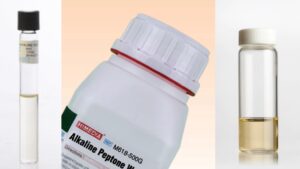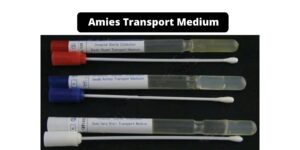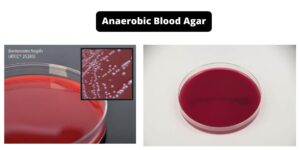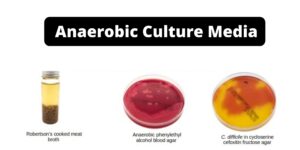What is Brilliant Green Agar?
- Brilliant Green Agar (Modified) is a selective medium used for the isolation and identification of Salmonella species, excluding Salmonella Typhi, from feces and other materials. Salmonella is known to cause various infections, ranging from mild gastroenteritis to severe typhoid fever. Brilliant Green Agar Base, Modified, was initially described by Kristensen et al. and later modified by Kauffmann for enhanced selectivity.
- The presence of brilliant green in the medium inhibits the growth of the majority of Gram-negative and Gram-positive bacteria, including Salmonella Typhi, Shigella species, Escherichia coli, Pseudomonas species, and Staphylococcus aureus. Clinical specimens can be directly plated on Brilliant Green Agar, but it is recommended to use it alongside a less inhibitory medium to increase the chances of recovering the target Salmonella species. Often, cultures enriched in Selenite or Tetrathionate Broth are plated on Brilliant Green Agar in conjunction with other selective plating media such as Bismuth Sulphite Agar, SS Agar, and MacConkey Agar.
- The medium contains proteose peptone and yeast extract as sources of carbon, nitrogen, vitamins, amino acids, and essential nutrients. Lactose and sucrose are included as energy sources, and their fermentation by bacteria results in the production of acidic pH, which can be detected by the phenol red indicator. Sodium chloride maintains osmotic equilibrium, while brilliant green inhibits the growth of contaminating microflora. In cases where the sample is suspected to contain a large number of competing organisms alongside Salmonella species, the medium can be supplemented with sulphacetamide and sodium mandelate to further inhibit contaminating microorganisms.
- Non-lactose fermenting bacteria typically develop white to pinkish red colonies within 18-24 hours of incubation on Brilliant Green Agar. It is recommended as a primary plating medium for the isolation and identification of Salmonella species, and it is commonly used alongside other selective plating media for optimal results, depending on the specific Salmonella strains or samples being tested.
Principle of Brilliant Green Agar
The Brilliant Green Agar is a specialized medium used in microbiology for the selective isolation and identification of certain bacteria, particularly Salmonella, Shigella, Escherichia coli, Proteus, Pseudomonas, and Staphylococcus aureus. It contains a combination of nutrients, inhibitors, and indicators that aid in the growth and differentiation of specific bacterial species.
The medium’s composition includes peptone, tryptone, and yeast extract, which provide essential nutrients and amino acids necessary for bacterial growth. This combination ensures the medium is highly nutritious, supporting the growth of a wide range of bacteria and supplying long chains of peptides. Sodium chloride is added to maintain osmotic equilibrium, creating a suitable environment for bacterial growth.
Lactose and sucrose are included as fermentable carbohydrate sources. These sugars are utilized by specific bacteria, leading to the production of acids during fermentation. Brilliant Green Agar employs phenol red as an acid-base indicator, which turns yellow in the presence of lactose- or sucrose-fermenting bacteria. This color change assists in the identification of these organisms.
One of the key components of Brilliant Green Agar is brilliant green itself. Brilliant green acts as an inhibitory agent, preventing the growth of a wide range of Gram-negative and Gram-positive bacteria. This inhibition is particularly effective against Salmonella Typhi, Shigella species, Escherichia coli, Proteus species, Pseudomonas species, and Staphylococcus aureus. These bacteria are mostly suppressed on the medium, allowing for the selective isolation and identification of other target organisms.
The appearance of colonies on Brilliant Green Agar can provide valuable information for bacterial identification. Non-lactose fermenting bacteria typically develop white to pinkish red colonies within 18-24 hours of incubation. These colonies are easily distinguishable due to their lack of color change in the presence of lactose or sucrose fermentation.
On the other hand, lactose or sucrose fermenting organisms that are normally inhibited on this medium will produce yellow to greenish-yellow colonies. These colonies are surrounded by intense yellow-green zones in the agar. This characteristic color change aids in the identification of Escherichia coli or the Klebsiella/Enterobacter group, which are known to ferment these carbohydrates.
Additionally, there may be red-pink-white opaque colored colonies surrounded by brilliant red zones in the agar, which are most likely salmonella (but not Salmonella Typhi). Proteus and Pseudomonas species, although usually inhibited, may grow as small red colonies.
Overall, the principle of Brilliant Green Agar lies in its ability to provide a nutrient-rich environment for bacterial growth while selectively inhibiting certain bacteria. By incorporating specific indicators and inhibitors, the medium facilitates the identification of lactose or sucrose fermenting organisms and the isolation of target bacteria such as Salmonella, Shigella, Escherichia coli, Proteus, Pseudomonas, and Staphylococcus aureus.
Composition of Brilliant Green Agar
| Ingredients | Gms/liter |
| Peptone | 5.000 |
| Tryptone | 5.000 |
| Yeast extract | 3.000 |
| Lactose | 10.000 |
| Sucrose | 10.000 |
| Sodium chloride | 5.000 |
| Phenol red | 0.080 |
| Brilliant green | 0.0125 |
| Agar | 20.000 |
Final pH (at 25°C): 6.9±0.2
Preparation of Brilliant Green Agar
The preparation of Brilliant Green Agar involves the following steps:
- Measure out 58.09 grams of Brilliant Green Agar powder and suspend it in 1000 ml of purified or distilled water. The water should be of good quality to avoid any contaminants that may interfere with the growth of bacteria.
- Heat the suspension to boiling while stirring continuously. This process helps in dissolving the medium completely, ensuring that all the components are uniformly distributed.
- After the medium has dissolved, it needs to be sterilized to eliminate any potential contaminants. The most common method of sterilization is autoclaving. Place the medium in a suitable container, such as a flask or bottle, and seal it properly. Autoclave the medium at 15 pounds of pressure (121°C) for 15 minutes. It is important to avoid overheating, as it can lead to the degradation of certain components or cause the agar to become excessively solidified.
- Allow the sterilized Brilliant Green Agar to cool down to a temperature of 45-50°C. This temperature range is suitable for pouring the medium into sterile Petri plates without causing damage or excessive condensation.
- Before pouring, ensure that the agar has cooled sufficiently to prevent any harmful effects on the growth of bacteria. Once cooled, mix the agar thoroughly to ensure uniform dispersion of any settled particles or aggregates.
- Using aseptic techniques, carefully pour the cooled and mixed Brilliant Green Agar into sterile Petri plates. It is crucial to maintain proper sterility during this step to prevent contamination of the medium.
- Allow the agar to solidify in the Petri plates before use. This can be achieved by leaving the plates undisturbed at room temperature or by placing them in a refrigerator.
Following these steps will yield properly prepared Brilliant Green Agar plates, ready for use in selective isolation and identification of specific bacterial species.
Method of Use of Brilliant Green Agar
The method of using Brilliant Green Agar for the examination of faeces or similar materials for salmonellae, as well as for the examination of foods, involves the following steps:
Examination of Faeces or Similar Materials for Salmonellae:
- Heavily inoculate a Brilliant Green Agar plate with the sample obtained from faeces or a similar material. Simultaneously, inoculate other plating media such as MacConkey Agar or Eosin Methylene Blue Agar, as well as tubes of Selenite Broth and Tetrathionate Broth. This allows for the simultaneous growth and detection of different bacterial species.
- Incubate the Brilliant Green Agar plate at a temperature of 35°C for 18-24 hours. This optimal incubation temperature supports the growth of salmonellae and aids in their detection.
- After the incubation period, carefully examine the plates. Identify suspect colonies that exhibit characteristics suggestive of salmonellae. These suspect colonies can be further confirmed using differential tests or serological methods specific to the identification of salmonellae.
- If no non-lactose fermenting bacteria are observed on the primary plate cultures, inoculate Brilliant Green Agar and other media with the enrichment cultures obtained from Selenite Broth or Tetrathionate Broth. Proceed with the identification process as described in point 3.
Examination of Foods:
- Take four 25g aliquots of the food sample and place them in separate containers with 75ml of Buffered Peptone Water. Incubate the containers at 35°C for 4-6 hours. This pre-enrichment step allows for the multiplication of bacteria present in the food sample.
- Add 75ml of double-strength Selenite Cystine Broth to each pre-enriched sample. Incubate the samples at 43°C for 24 hours. The Selenite Cystine Broth aids in the selective enrichment of salmonellae.
- Subculture from the Selenite Cystine Broth onto plates of Brilliant Green Agar and Bismuth Sulphite Agar (Modified). These agar plates support the growth of salmonellae and inhibit the growth of other bacteria.
- Incubate the plates at 35°C. After 24 hours, examine the Brilliant Green Agar plate for the presence of colonies with salmonella characteristics. After 48 hours, examine the Bismuth Sulphite Agar plate.
- Look for colonies on the Brilliant Green Agar plate that exhibit characteristics suggestive of salmonellae. Confirm their identity through biochemical and serological tests specific to salmonella identification.
By following these steps, Brilliant Green Agar can be effectively utilized for the detection and identification of salmonellae in faecal samples or similar materials, as well as for the examination of salmonellae in food samples.
Result Interpretation on Brilliant Green Agar
When interpreting the results on Brilliant Green Agar, the following observations and characteristics can guide the identification of bacterial colonies:
- Salmonella colonies: Typical Salmonella colonies on Brilliant Green Agar appear as pinkish-white or red colonies surrounded by a red halo within the medium. This differentiation is quite distinct.
- Lactose or sucrose fermenting organisms: These organisms, which are either uninhibited or can overcome inhibition on Brilliant Green Agar, produce yellow-green colonies with a green halo. This color change is indicative of their ability to ferment lactose or sucrose.
- Biochemical and serological tests: To complete the identification of isolated colonies, it is recommended to perform additional tests such as biochemical and/or serological tests. These tests provide further information for accurate identification.
- Slow lactose fermenters: Some organisms, such as Proteus or Pseudomonas species, may appear as red colonies on Brilliant Green Agar. However, it’s important to note that these colonies may be smaller in size compared to Salmonella colonies.
- Inhibition of gram-negative organisms: While it is often stated that the dye brilliant green inhibits gram-negative organisms like E. coli, it is inconsistent with the observation that enteric organisms can still flourish in brilliant green broth with a higher concentration of brilliant green. This suggests that the inhibitory effect may vary.
Non-lactose/sucrose-fermenting organisms: Red-pink-white opaque colored colonies surrounded by brilliant red zones in the agar are highly likely to be Salmonella colonies, but not specifically Salmonella typhi.
Proteus and Pseudomonas species: These species may grow as small red colonies on Brilliant Green Agar.
Lactose/sucrose-fermenting organisms (normally inhibited): Yellow to greenish-yellow colored colonies surrounded by intense yellow-green zones in the agar are indicative of organisms such as Escherichia coli or the Klebsiella/Enterobacter group, which can ferment lactose or sucrose.
By carefully observing the colony appearance and characteristics on Brilliant Green Agar, along with the use of appropriate identification tests, accurate identification of bacterial species can be achieved.
| Organisms | Growth |
| Salmonella typhimurium | Good growth; red-colored colonies |
| Salmonella Abony | Good growth; pinkish white |
| Salmonella Enteritidis | Good growth; pinkish white |
| Salmonella Typhi | Poor-good; reddish pink |
| Staphylococcus aureus | Inhibited |
| Escherichia coli | Inhibited or no growth; yellowish-green |
| Enterococcus faecalis | No growth to light growth; yellowish colonies with or without yellow halos |
Quality Control of Brilliant Green Agar
Quality control of Brilliant Green Agar involves assessing various aspects such as appearance, gelling, color and clarity of the prepared medium, pH, and cultural response. The following information describes the quality control parameters:
- Appearance: Brilliant Green Agar should have a light yellow to light pink homogeneous free-flowing powder appearance.
- Gelling: The gelling property of Brilliant Green Agar should be firm, comparable to a 2.0% agar gel. This indicates the agar’s ability to solidify properly.
- Color and Clarity of Prepared Medium: The prepared Brilliant Green Agar should have a greenish-brown clear to slightly opalescent gel in Petri plates. This indicates the proper dissolution and distribution of the medium components.
- Reaction: A 5.8% w/v aqueous solution of Brilliant Green Agar should have a pH of 6.9±0.2 at 25°C. This pH range is considered acceptable.
- pH: The pH range for Brilliant Green Agar is 6.70-7.10.
- Cultural Response: The cultural response of the medium is evaluated after incubation at 30-35°C for 24-48 hours. The recovery rate of bacteria growth on Soybean Casein Digest Agar is considered as 100% for comparison.
- Cultural Response Organism Inoculum Growth: Different bacterial strains, such as Escherichia coli, Staphylococcus aureus, Salmonella Typhi, Salmonella Typhimurium, Salmonella Enteritidis, and Salmonella Abony, are inoculated on Brilliant Green Agar. The growth and appearance of colonies are observed and recorded. The expected color and cultural responses for each strain are specified in the provided data.
By conducting quality control tests according to these parameters, it ensures that the Brilliant Green Agar is of appropriate quality and can be reliably used for microbiological applications.
| Organism | Inoculum | Growth (CFU) | Recovery | Colour of Colony | Cultural Response |
|---|---|---|---|---|---|
| Escherichia coli ATCC 25922 | 50-100 | None-poor | 0-10% | – | None-poor |
| Escherichia coli ATCC 8739 | 50-100 | None-poor | 0-10% | – | None-poor |
| Escherichia coli NCTC 9002 | 50-100 | None-poor | 0-10% | – | None-poor |
| >=10³ | Inhibited | 0% | – | Inhibited | |
| Staphylococcus aureus | >=10³ | Inhibited | 0% | – | Inhibited |
| subsp. aureus ATCC 6538 | |||||
| Salmonella Typhi ATCC 6539 | 50-100 | Fair-good | 30-40% | reddish pink | yellowish green |
| Salmonella Typhimurium | 50-100 | Good-luxuriant | >=50% | pinkish white | yellowish green |
| ATCC 14028 | |||||
| Salmonella Enteritidis ATCC | 50-100 | Luxuriant | >=50% | pinkish white | yellowish green |
| 13076 | |||||
| Salmonella Abony NCTC 6017 | 50-100 | Good-luxuriant | >=50% | pinkish white | yellowish green |
| Staphylococcus aureus | |||||
| subsp. aureus ATCC 25923 | >=10³ | Inhibited | 0% | – | Inhibited |
Uses of Brilliant Green Agar
Brilliant Green Agar has several important uses in microbiology, including:
- Selective Isolation of Salmonella Species: Brilliant Green Agar is primarily employed as a selective medium for the isolation of Salmonella species, excluding S. Typhi and S. Paratyphi, from clinical specimens. It provides a favorable environment for the growth of Salmonella while inhibiting the growth of other bacteria, allowing for the selective isolation of these pathogens.
- Recommended by APHA FDA: Brilliant Green Agar is recommended by the American Public Health Association (APHA) and the U.S. Food and Drug Administration (FDA). These regulatory bodies endorse the use of this medium, highlighting its reliability and suitability for microbiological testing.
- Testing Clinical Specimens: Brilliant Green Agar is commonly used in clinical laboratories to test various clinical specimens for the presence of Salmonella. The outstanding selectivity of the medium allows for the analysis of heavy inocula and heavily contaminated samples, facilitating the detection and identification of the pathogen.
- Microbial Limits Testing: Brilliant Green Agar finds application in microbial limits testing, particularly in the pharmaceutical industry. It is used to assess the microbial contamination of pharmaceutical products, ensuring their compliance with safety standards and regulations.
- Testing Food Products: Brilliant Green Agar is also utilized in the analysis of food products. It is employed in conjunction with novobiocin, an antibiotic, for the detection of Salmonella in food samples. This helps ensure the safety and quality of food by identifying the presence of Salmonella contamination.
Overall, Brilliant Green Agar is a valuable medium for the selective isolation and identification of non-Typhi and non-Paratyphi Salmonella species in clinical specimens. Its use is recommended by regulatory bodies and it plays a crucial role in microbial limits testing for pharmaceutical products as well as the analysis of food samples for Salmonella contamination.
Limitations of Brilliant Green Agar
While Brilliant Green Agar has several advantages, there are limitations to its use. These limitations include:
- High Selectivity: Brilliant Green Agar’s high selectivity can inhibit the growth of certain bacterial species, including Salmonella typhi and Shigella species. To increase the chances of recovery, it is recommended to use this medium in combination with less inhibitory media such as Selenite or Tetrathionate Broth, Bismuth Sulphite Agar, SS Agar, or MacConkey Agar.
- Non-Growth of Specific Pathogens: Salmonella typhi, the causative agent of typhoid fever, and certain Shigella species may not grow on Brilliant Green Agar. In such cases, alternative media must be used to support the growth and identification of these pathogens.
- Potential Mimicking by Other Species: Some bacterial species like Proteus, Citrobacter, and Pseudomonas have the potential to mimic enteric pathogens. They may produce small red colonies on Brilliant Green Agar, leading to misinterpretation. Additional biochemical and/or serological tests should be performed on isolated colonies to ensure accurate identification.
- Incomplete Identification: While Brilliant Green Agar aids in the initial isolation of target bacteria, it does not provide definitive identification. Biochemical and serological tests are necessary to complete the identification process, as these tests offer more specific information regarding the isolated colonies.
FAQ
What is Brilliant Green Agar used for?
Brilliant Green Agar is a selective and differential medium used for the isolation and identification of Salmonella species (excluding S. Typhi and S. Paratyphi) from various sources.
What makes Brilliant Green Agar selective?
Brilliant Green Agar contains the dye brilliant green, which inhibits the growth of a wide range of Gram-negative and Gram-positive bacteria, making it selective for Salmonella species.
How does Brilliant Green Agar differentiate between different bacterial species?
Brilliant Green Agar differentiates bacteria based on their ability to ferment lactose or sucrose. Lactose/sucrose fermenting organisms produce yellow-green colonies with a green halo, while non-fermenters develop pinkish-white or red colonies with a red halo.
Can all Salmonella species grow on Brilliant Green Agar?
No, Brilliant Green Agar may not support the growth of Salmonella Typhi and some Shigella species. Alternative media are required for the isolation of these pathogens.
Can other bacterial species mimic Salmonella colonies on Brilliant Green Agar?
Yes, certain species like Proteus, Citrobacter, and Pseudomonas can produce small red colonies, which may resemble Salmonella colonies. Additional tests are needed to confirm their identity.
How should Brilliant Green Agar be used in conjunction with other media?
To increase the chances of recovery, Brilliant Green Agar is often used alongside less inhibitory media such as Selenite Broth, Tetrathionate Broth, Bismuth Sulphite Agar, SS Agar, or MacConkey Agar.
What are the recommended incubation conditions for Brilliant Green Agar?
Brilliant Green Agar is typically incubated at 35°C for 18-24 hours. However, specific incubation times and temperatures may vary depending on the purpose of the test and the organisms being targeted.
Can Brilliant Green Agar be used in food and pharmaceutical testing?
Yes, Brilliant Green Agar is employed in the microbial limits test for food and pharmaceutical products to assess the presence of Salmonella contamination. It can be used in combination with novobiocin for this purpose.
Does Brilliant Green Agar provide complete identification of Salmonella species?
No, Brilliant Green Agar is primarily used for the initial isolation of Salmonella species. Additional biochemical and serological tests are required to complete the identification process.
Is Brilliant Green Agar recommended by regulatory bodies?
Yes, Brilliant Green Agar is recommended by organizations like the American Public Health Association (APHA) and is in accordance with the United States Pharmacopoeia, making it a recognized and widely used medium for microbiological testing.
References
- https://assets.fishersci.com/TFS-Assets/LSG/manuals/IFU110112.pdf
- https://hardydiagnostics.com/media/assets/product/documents/BrillGrnAgar.pdf
- https://www.neogen.com/globalassets/pim/assets/original/10006/ncm0058_ts_en-us.pdf
- https://www.sigmaaldrich.com/deepweb/assets/sigmaaldrich/product/documents/353/165/70134dat.pdf
- https://www.dalynn.com/dyn/ck_assets/files/tech/PB84.pdf
- http://www.oxoid.com/UK/blue/prod_detail/prod_detail.asp?pr=CM0263&org=124&c=UK&lang=EN
- https://www.humeau.com/media/blfa_files/TC-Brilliant_Green_Agar_55017030054-10022_EN_150518.pdf
- https://exodocientifica.com.br/_technical-data/M016.pdf



